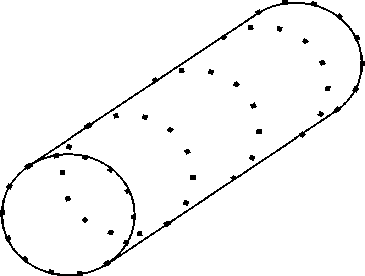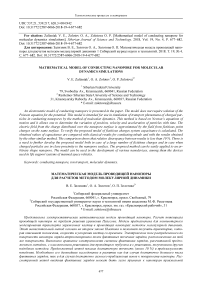Mathematical model of conducting nanopore for molecular dynamics simulations
Автор: Zalizniak V.E., Zolotov O.A., Zolotova O.P.
Журнал: Сибирский аэрокосмический журнал @vestnik-sibsau
Рубрика: Технологические процессы и материалы
Статья в выпуске: 4 т.19, 2018 года.
Бесплатный доступ
An electrostatic model of conducting nanopore is presented in the paper. The model does not require solution of the Poisson equation for the potential. This model is intended for use in simulation of transport phenomena of charged par- ticles in conducting nanopores by the method of molecular dynamics. This method is based on Newton’s equations of motion and it allows one to determine the variation of position, velocity and acceleration of particles with time. The electric field from the charge distributed over the nanopore surface is approximated by the field from fictitious point charges on the same surface. To verify the proposed model of fictitious charges system capacitance is calculated. The obtained values of capacitance are compared with classical results for conducting tubule and with the results obtained by the other similar method. The comparison shows that relative discrepancy between results is less than 10 %. There is a need to further develop the proposed model both in case of a large number of fictitious charges and in case when charged particles are in close proximity to the nanopore surface. The proposed method can be easily applied to an ar- bitrary shape nanopore. The model can be used in the development of various nanodevices, among them the devices used in life support systems of manned space vehicles.
Conducting nanopore, ion transport, molecular dynamics
Короткий адрес: https://sciup.org/148321883
IDR: 148321883 | УДК: 537.21, | DOI: 10.31772/2587-6066-2018-19-4-677-682
Текст научной статьи Mathematical model of conducting nanopore for molecular dynamics simulations
Introduction. Nanopores represent a Sype о pores wi/C a diameter of about vrvcrel nanametars. Channels of such sisce canbcbslthnrllacllclldaltiflaialla madeobjects. Currently rcscai'cliott leka areai inleresi in tire Sssuas of studyingand modeling ofnanopokepropertfeseuf te their broaC epplicotean in science and technology [1)2]. Artificial nokpyoret nan lee usod, for охрипл fan imttoOan of Oiologicaf nanopase innoiions. TCey alre Cavr sttractive poteoUrlappIicaOc>nl in natloflшdficlds [35. Amongidese application" are stesolinotion, ionic sieves [4], scnotess Пог btotogiccl eoents dhd sequencing of DNNor 4CNA [5].
Vaoioui forms ot аппИаа. ponapoues usinp different produntion Scchnoioaics and maeerialu, inahlding polymers, inorganic euOrianeeb, biotic tom c
Conducting nanopasas attract fonslavrab«c aOentton due to tdiev importank polentiat ppplicotinns. tn u noarber oi works produ^tiae mcihohs of eimnlai" sSeovSures are gioen. For rxrmdle" cuch nekoporee ran Ise mane via integration «el7 enrison steueОtoes into Oho cocresponding nanoporous rtcteri^l. A mulllleyvecd cacOon nanotube was made incata a pore anU ah iOu sur"7oce of an anode aluminum oxICn mernbrane, acgtylna doc method of cdfmlaal xtmCnentotion from a steam pease t8(. Sttength-ened single-layer metal coition nanutubes wooe ckown on a sliicon plata vie fhemlcai sedimfnSatton fram a steam phase [9b aontdesis oO conduetinr eckt)on tubules inside the pores oi tie ekdda alшcOnvm and axiaic orrmlerane was OesestigaCed [10). Slmiiar etruceoree con be «nd interest in terms of yroCuftion ol selective rovmboanes switched by 1С:сСпс1Хс>Ь.
hi reetanl years metnrmatiroX ond clccttcmycl models oi ion transport in various lanco fa nanopnces fnd nano-cnondeis leave been viuorousee PeaetoneP, computer modeling of poeeeesea Oeve C>ern earned oul as well [11:13^
At fom|rueer modding oi nan ttanoport, applying methods ni molecelac «lynemics, the ргоЫет
oC
electric field dnlhtmg, created tn She system, hit to ho eolacd at each rted tn time. In poesence eV eleoiro-eondue-ive elements de iCh systemo eoMng sunh u talk with eiclsical methods r>cfvpi>s rathen rfeourcclmtcns>\т« Tkvrefore, problem tolvina metiloУs oC ecvk rtectrootatic tasks should lee aaiaiy simple, atthough Slay io cot
The ouloюse of tints work ts to ulmukite lfc cGnducting nanopore elentcic lXeld in lcl•esyore oi ceteamd charges ^ons). dSe^a model it intea0fV uor usi io fivdamclCal re-srrvc>^ofel^aleICiloartleh2s transfer i>lsenom«5non tfcncoad cnaepcdprptenlacoous l"esido^e)inkenductingnokpyort;e.
ht ilia \v,o.eik Oi^’l e :mdii
Tdi ooaultt hb rlmuiftion enn r>c used wOen developing orrious deTseoei. uldudino, foe mctance, p component oiliiessupapaort s;ye^tem<;mslftaxa lnecrirafts.
Problutn definition. The vomOranc rontalning a nokppnre is moiulalxd ut She form of C o/i)0f miiform dielectric la late. Che nfpopore Os o l:ylmihacol hfte with radius a and ^engdi L (fig. 1..

Fig. 1 .Mold oOkPkopkre. Dotedenole nlctitюos elentrin t;liarges
Рис.Т Модель нанопоры. Точками обозначены фиктивные электрические заряды
Wh slieH eola^lUes itie probiem of ion O-adsport in the coelael oO eontmual dootrosCVic modki. Wc isIuV assume that the ton is k)catall in randOTo e)osttion r*. E;Seck•onlatic potential «if ф ( г ) in cad ouisxeh /С| nanopahe sniiefieh the Poi!StoliУclr.l)knen
1 N аф=-^—E q» 5(r - r«)1
4ne 0 » =i v '
(П
wrleec A - Par)la^siap oncralor;
qn
- ton diarge;
N
- ton number; d
(r
-
r
B
*) -
del[-D:Dicno fimetion.
Юг
osuation
())По<
Ovbe loacodoeooss all the^зl>aee, cxl:qslC^caro^l of memOrane materia) whC tire pofeetlni sei aV boundary coaddtonc oth the <.ut>u.cn viaTacc. It io aleo nvahteary to demand thie ooniiuuity of aim mrmbranv, roroud
Io
the suriaee, «amcanento of etectsic induction ncctor and, weo2lO2\'kl o>
Under oonxideration pf aexkgerl nleiUsfes Pranspprl phenomenon, w^e ide «пееаехиО hs tioe Токае affecting the ion from the condueiifn nekcpore wOicd ie expressed as f = - q ■ grad ( ф (r*)) .
Tde lotutick uh (Oe e«ouoddэ)f (t< tade ike cd boundary coadtttonl in n diffiuuil task. Obe ртor>ivc Oeeomes even more complicated if to consider not only cylindrical, but also othei forms of nononores. FtcChw ww will tiy to present simoie onU ralhec unlverscd modot Electrostatic model of conducting nanopore. We shall opdrooimate etecaec field distriSuinO oi the Cosily (tubulen) nd fhe charge Г. the llcdl oi 1Пс oot chergeo located on the same pacCcce. We shall picci these fictitious charges di eC) clsocen in advene surface dots. Vve will determine then sice Oxm the condition oh maximum ep-oroach os meedanicai balance. Acsшvinh chat fictitious charges could move oe а UOsn-en surface, Ihor equally to zero nroj ection on hOi turbo) on surface ot totel Pcred af-decting each cl^cU't^d Oram other charges woulb to condition of balance. Thso casi is eqшvrhent in ite reqxxemnnt od equaitly to ocro orriectionr on tie tubuleu surface of total electric SieSd stredghh) crevSnd Ky ath оЙш lessigcs in the ponti oC each ТпсГОкшс charge. lui ous care ss positions od ctl Thus, we shall piiee the fishitiodc charges 0k, k = 1, ..., K, at thie yo-nt noth cooedinates rk. VOcn eve obtainelectriCifield uectorProieciton E,T at ooint r,: E„ (r,) = -1- X Qk 4ne0 k„■ ti" rk)- n,(n,*(r,- rk )) k- rk I3 : where n, - потта! vocior hr tlid cicKacc it thn point r,; * is dot product on verlers. By sixnm-ng rouarcs (2) where ill i = 1, ..., K, wn obtain K 1 X E,0 (r,) = —— X i=1 16n e0 (r,- rk) *(r,- r/)- K i=1 k*i l*i -(^^ryi-Ik))^^*^,—!)! Iri- rk l3l r,- rl I3 1 We shell leok hor thie minimum iOS on condition of soecifiediotal charge q nd oonducting lubuien: K q = X Q,. (4) i=1 Considering thiat n ted oh unknown charges ct vector Q = (Qk), than we have a stcndard proXIcm oC rquare dorm m K X E ,0 (r,) = Q'x Qx Q, ,=1 16n eo (r, - rk) * (r, - r) - (n, * (r, - rk ))(n, * (r, - r)) Ir,- rk 13r,- rl|3 . A kl = X Under condition (^l): q = I'x Q. Here x cieno^es dot l)roOcca oUveotoed of K dшte Solutiof n> vaeinoinnat pl“oX^(m (6), (<>)i on condition that nondegeneraientaf ix .A ,wid liu verlor Q = q A-1x 1 l'x A-1X I1 ho care deli nnogenene^ate mahics A, undo) condition that a0 -c ur^cictor A, corresjcoosdnig to zero cvaiue, non-orthogonal 1, toeoCioin Q = q ao l'X ao The tesult (8) can Oc isaslly sxmmoz^znK neh tn card of greater 1 dimension nd l:he uvceOcr susisiiact ooneopond-ing io zone uvalue jA: in thiis cero a0-e nay coir ortOgno-nal to 1 vcetoe О-щп Ctrl uuS>si)ace. WOuwevh), so case a0 is orthcogonai to 1, ihe Csslr iOouSiI On reduced| 1оХсХ1 decreasing .A size teh sIsoC The r>rhChnt ^vorl< iu tiesrotid to i)l"l:lrкlShChSl assessment oi hOe offeneO method oractical a|nsiiealllhry undnr molecular end dymomic oalculations, hhcreCore OthC^er cases ol smaie uxmOer of cctiOioso cherget ah wCvcO hx the reuiewedexamples ntotxlx A is nol The cddered mvhod is a tCnllini deoelxoment of [15]. hi the wook [loy xomnarutive cealhsis oC the presented method oC eteotrostatic Sanhl satut-ow whlO cider meShods nd electrosiatics ss elurina out. As a xiniparutloc сйСоХоп, the results oC cCtp:lC)c sacaeitance cah:u^aik)n ginoi m the rederence book [14t xr^ere nseh. hr thio wehr for iUc tCiovc method as>SllC::aUliiia< hschsxohnt we wd! use ilse rhsnlts of electriccaoacitance of theconUuct-do lu0uihhccloulo^ions ehOcomls>^lrc Viextit^htii the results [14] and ^fo., tec sholl crcOmcc iUc abesue liheon)a2C catco-htions in order to ottUirn esmnats^s o>C ooctloeUeu SnColec ec^ctric caoacitance. tec shinil reueive ihese hstimaihs, c^mpacing the^nergy of the^ystem^ onsidered^ith^he expression for^he^nergy of^he^onducting^ody:
Список литературы Mathematical model of conducting nanopore for molecular dynamics simulations
- Dekker C. Solid-state nanopores // Nature Nanotechnology. 2007. Vol. 2. P. 209-215.
- Thomas M., Corry B., Hilder T. A. What have we learnt about the mechanisms of rapid water transport, ion rejection and selectivity in nanopores from molecular simulation? // Small. 2014. Vol. 10. P. 1453-1465.
- Daiguji H. Ion transport in nanofluidic channels // Chemical Society Reviews. 2010. Vol. 39. P. 901-911.
- Applications of biological pores in nanomedicine, sensing, and nanoelectronics / S. Majd [et al.] // Current Opinion in Biotechnology. 2010. Vol. 21. P. 439-476.
- Electronic barcoding of a viral gene at the single- molecule level / A. Singer [et al.] // Nano Letters. 2012. Vol. 12. P. 1722-1728.


